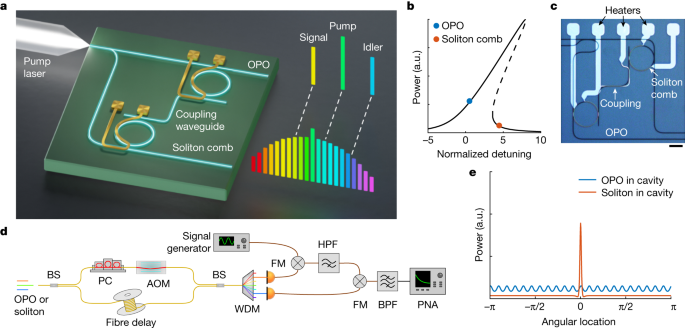Achieving All-Optical Frequency Division on-Chip with a Single Laser
Core Concepts
The author demonstrates the successful implementation of all-optical OFD on a photonic chip using a single laser, eliminating the need for multiple lasers and electronic feedback components. This approach achieves high-quality microwave oscillations and significant phase-noise reduction.
Abstract
Spectrally pure microwave signals are crucial in various scientific fields, such as metrology and communications. The content discusses the use of optical frequency combs for optical frequency division (OFD) to generate high-quality microwave oscillations. By synchronizing two dynamical states of Kerr microresonators pumped by a single continuous-wave laser, all-optical OFD is achieved on a photonic chip without the need for electronic locking. This method results in significant phase-noise reduction and offers a pathway towards compact devices capable of generating pure microwave frequencies.
All-optical frequency division on-chip using a single laser - Nature
Stats
OFD factors of N = 34 and 468 are achieved for 227 GHz and 16 GHz soliton combs, respectively.
A 46 dB phase-noise reduction is observed for the 16 GHz soliton comb.
Quotes
Key Insights Distilled From
by Yun Zhao,Jae... at www.nature.com 03-11-2024
https://www.nature.com/articles/s41586-024-07136-2
Deeper Inquiries
How can the concept of all-optical OFD impact advancements in communication technologies
The concept of all-optical OFD can significantly impact advancements in communication technologies by offering a more efficient and compact method for generating spectrally pure microwave signals. Traditional methods often require multiple lasers, complex stabilization techniques, and electronic feedback components, leading to larger device footprints that are not conducive to integration into compact photonic platforms. By demonstrating the synchronization of dynamical states in Kerr microresonators using a single continuous-wave laser on a photonic chip, this approach eliminates the need for electronic locking and reduces the complexity of the system. This simplification paves the way for developing chip-scale devices capable of producing high-quality microwave frequencies essential for various communication applications.
What potential challenges or limitations could arise from implementing this technology on a larger scale
While all-optical OFD presents promising opportunities for advancing communication technologies, several challenges and limitations may arise when implementing this technology on a larger scale. One potential challenge is scalability; as the system grows in size or complexity, maintaining synchronization between different dynamical states within Kerr microresonators could become increasingly difficult. Additionally, issues related to power consumption and heat dissipation may emerge as more components are integrated onto a single chip. Ensuring long-term stability and reliability under varying environmental conditions also poses a significant challenge when transitioning from laboratory demonstrations to real-world applications. Addressing these challenges will be crucial in realizing the full potential of all-optical OFD in practical communication systems.
How might the stability achieved through all-optical OFD influence future developments in photonics research
The stability achieved through all-optical OFD has profound implications for future developments in photonics research by enabling new possibilities for generating high-quality microwave signals on-chip. The ability to transfer terahertz beat frequency stability to microwave frequencies without electronic locking opens up avenues for exploring novel applications where precise timing and low phase noise are critical factors. This breakthrough could lead to advancements in fields such as quantum information processing, radar systems, precision metrology, and wireless communications by providing an efficient means of generating stable microwave oscillations with reduced phase noise levels compared to conventional approaches. The success of this work demonstrates how leveraging optical frequency combs can revolutionize integrated photonics platforms and drive innovation across various scientific disciplines requiring reliable frequency generation capabilities at microwavescales.
0
